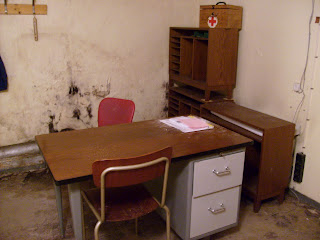 There was an open house at one of the big forts in Boden, not far from us. There are five big ones, and one of them, Rödbergsfortet (=Red Mountain Fort) has been turned into a museum. This one, Södra Åbergsfortet (=South River Mountain Fort) will now be closed, probably forever. Closed as in buried under meters of soil. I believe the main concern is the so called "urban explorers" going in and getting hurt. Of course this was an opportunity not to be missed, and we were not the only ones to think so. The queue was long, some turned the second they saw it, others, like us, waited patiently for the almost hour and a half it took to get in. It was the only time this year so far I could have had use of a hat and some sunblock.
There was an open house at one of the big forts in Boden, not far from us. There are five big ones, and one of them, Rödbergsfortet (=Red Mountain Fort) has been turned into a museum. This one, Södra Åbergsfortet (=South River Mountain Fort) will now be closed, probably forever. Closed as in buried under meters of soil. I believe the main concern is the so called "urban explorers" going in and getting hurt. Of course this was an opportunity not to be missed, and we were not the only ones to think so. The queue was long, some turned the second they saw it, others, like us, waited patiently for the almost hour and a half it took to get in. It was the only time this year so far I could have had use of a hat and some sunblock.Because so many people turned up, the original plan of guiding groups was cancelled and more help had to be called in. We were allowed to walk by ourselves, around 50 at a time, and guards/guides were placed at strategic places to help us not get lost and answer questions. Some of them didn´t really know much, but many of the visitors were very knowledgeable and more than happy to share.
There are a lot of people, not just in Boden, who have strong connections to the forts. Many have had fathers, husbands and brothers working there (not so many wives and daughters, perhaps) and since everything was top secret during the Cold War, there was always something of a mystery about them. Walking through this old underground castle was clearly emotional for some.
This is the old office of "fältväbeln", the lower rank officer who was in charge of the place, making sure that the fort was running smoothly and everyone had everything they needed. A bit like a porter in an Oxford college, I suppose.
Not a fancy sign, exactly. Not much in this place was made to impress.
There were some old maps and notes, guard lists and such lying about. Some snuck a page or two in their pockets and handbags - I suppose anything might work as a souvenir.
Condensation is a really big problem down there. These are the barrack rooms, and they all have sloping roofs and rain gutters. Also, there are dehumidifiers all over the place.
We took our time, taking pictures everywhere. Some walked past us pretty fast, we heard some say it only took ten minutes to get through it. I didn´t time us exactly, but I´m sure we spent almost an hour in there. There were lots of nooks and crannies to expore.
This lamp is signaling that the shock wave doors are to be kept shut. Words like that, "shock wave", "gas confines", reminded us of the whole zeitgeist of the Cold War. When my husband was doing his military service, the threat from the East was percieved as very real, indeed.
It seems now such an eerie place to be working at, but I suppose in it´s active days there would be loads of people here, lots of noise and activity. I wonder how much real fear they felt, the people who spent their whole working lives in places like these.
There were lots of rumours and myths regarding these forts. That they could shoot down ships in the harbour at Luleå, for example. This was not true, we have been told. But they liked to spread these kinds of tales, and perhaps they didn´t have to do a lot of lying themselves. Stories about what´s hidden often become exaggerate and fictionalized. Having something interesting to tell is social currency, and some of those tales were probably sold to spies, as well!









No comments:
Post a Comment